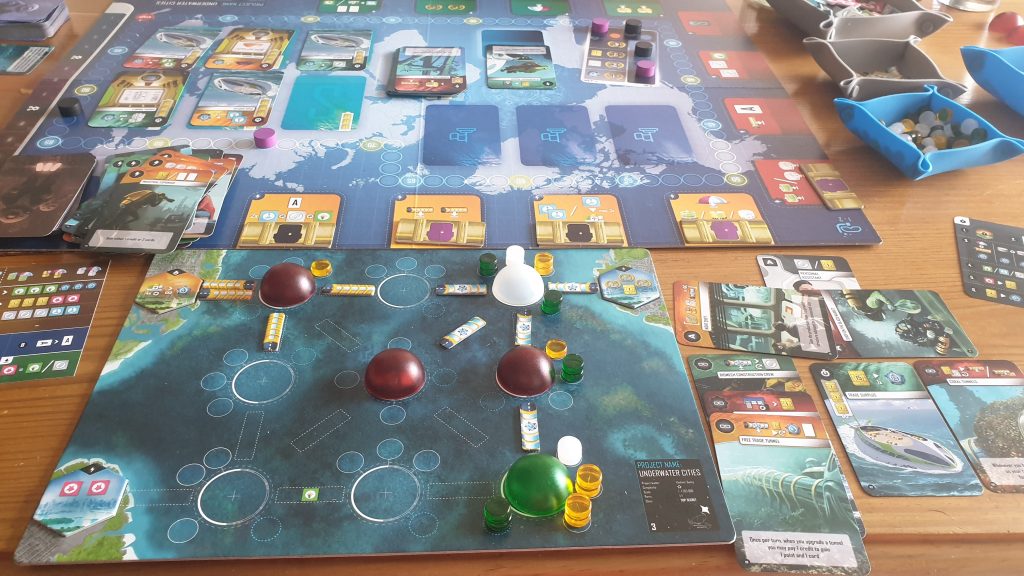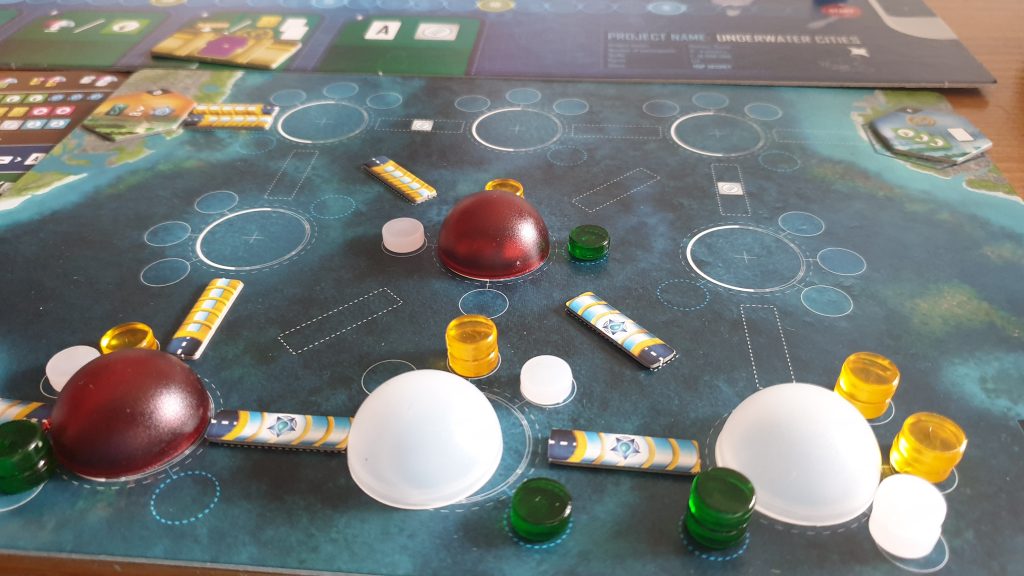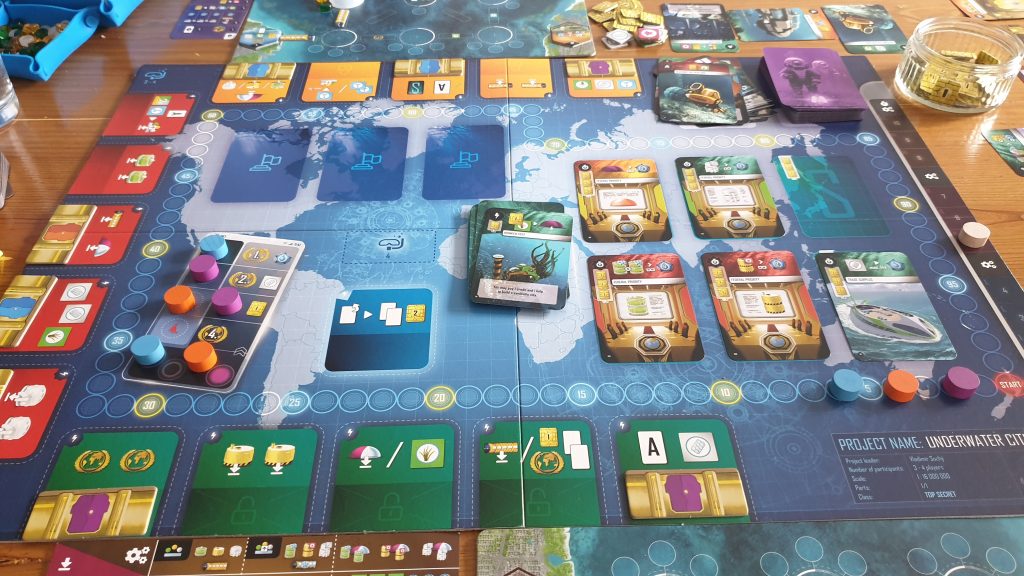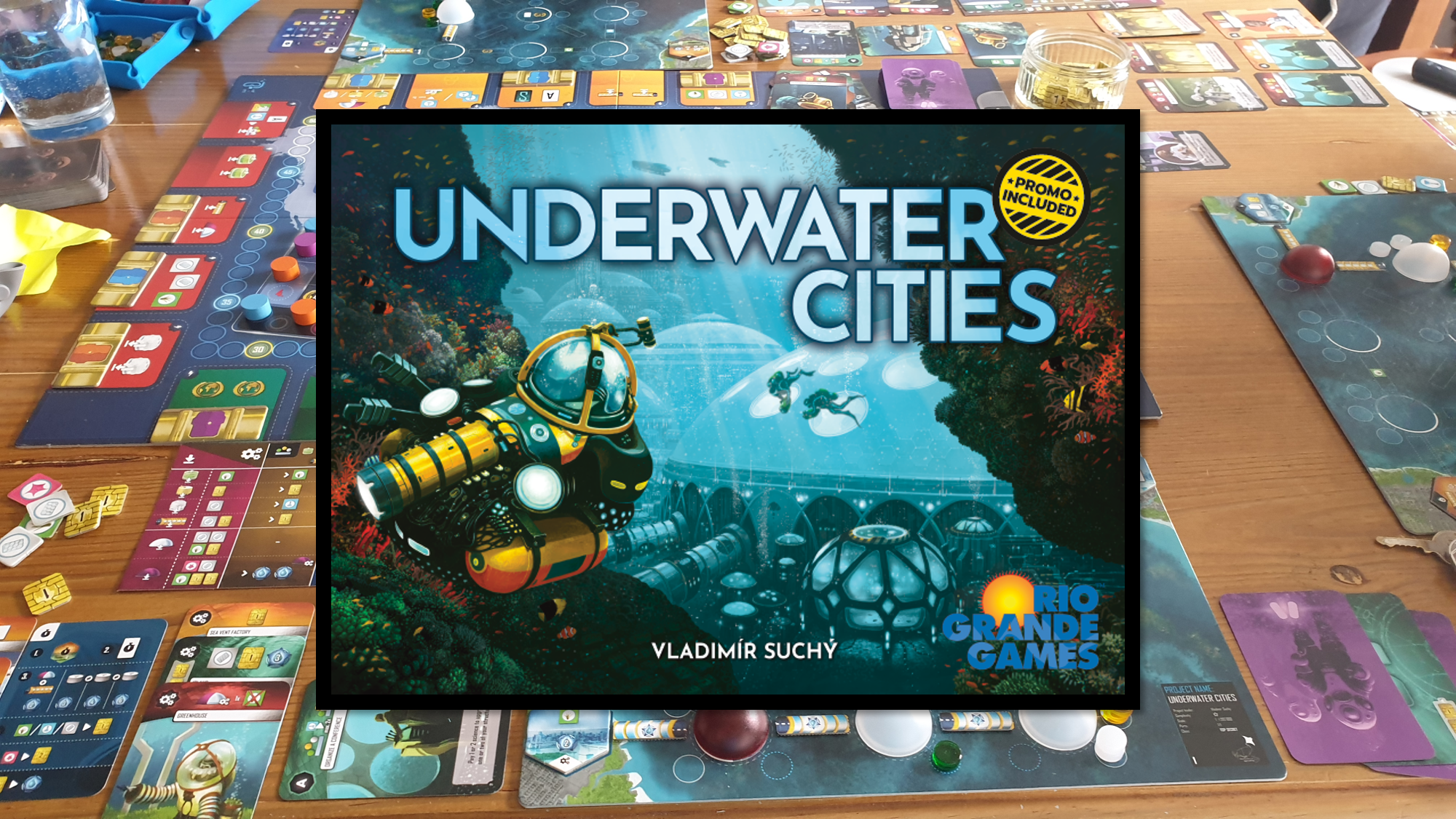Underwater Cities is a worker placement, city building and hand management board game that was released last year. Designed by Vladimír Suchý, featuring artwork from Uildrim and Milan Vavroň, 1 – 4 players are tasked with fixing the Earth’s population problem. Instead of looking to the stars the world’s brains turn to the oceans, to build a network of underwater cities to shelter and feed people. With the game lasting around 45 minutes per player, when up to speed, this isn’t exactly a fast game. However, is the journey into the depths of the sea a worthwhile one? Let’s find out!
During setup each player is given a player board. One side features a basic side, with the other an advanced/unique side. Each player also gains an identical action card and a reference sheet. Randomly distributed to each player are two blue and one brown metropolis tiles, which are placed onto their player board. The deck is separated, via different card backs, into the three Eras, with each being shuffled and stacked separately. Era 1 cards are then placed on the main board as the draw pile, with special “S” marked cards also added to the board. Finally each player is dealt six Era cards, being able to only keep three of them.
On a turn the active player chooses a card from their hand to play and a board location to activate. The board location is covered by one of the players three action tokens and is carried out. These come mostly in three colours green, yellow and red, though for the board action part the colour doesn’t matter. Depending on the location a specific action is taken; gaining resources, building Non-symbiotic/symbiotic cities or even taking special cards into your hand. Whatever the location it is then blocked for the rest of the round for all players.

The card played can be performed before or after the board action chosen, though is only available if the card colour matches the location. If the card colour does not match it is effectively just discarded. Cards aren’t all instant effects. Some will offer ongoing abilities, such as gaining credits for using the wrong colour cards when using board locations. Others will be actions that players can activate via specific board locations. At the end of your turn you draw a card, then must discard down to three cards before your next turn. The round ends when all players have used their three actions, seeing the round token moved on one step. Unlike many worker placement titles there is no way to get additional workers.
Most of the game will see players gaining resources, building and linking an underwater city on their personal player board. The player interaction comes in from blocking worker board locations before others and via an initiative “Federation” track. Advancing up the Federation track will gain players bonus points, credits or resources. It also determines the player order of the subsequent round, so there can be some conflict over specific actions that influence this. Note that this tracker is reset each round so the advantage that carries over is turn order.
At the end of the three eras, after rounds 4, 7 and 10, a production phase occurs. Based on the farms, desalination plants, laboratories and more built players gain resources and points. This is where upgraded buildings show their strength, with points and resources earnt. Additional bonuses are then awarded for having two identical upgraded buildings attached to one city. From production players will gain a boost of resources and credits. However, kelp must also be spent to feed the population of each city dome that is linked to their network, regardless of type.

At the end of the third era, post production, the game is over and it is time to score. Resources and credits convert into points, with some cards increasing their worth. The network of underwater cities and roads that players have constructed score based on the buildings adjacent to them and bonuses are awarded for connecting to metropolis tiles. At this point, whomever has the most points is the winner.
Timing has been somewhat of a common concern with Underwater Cities but past the initial playthrough this issue has mostly disappeared. With three players the initial playthrough took 3 hours – including teaching and a fair few rules checks. Whilst learning the gameplay did feel slow. Though, it wasn’t to the extent the game outstayed its welcome – no one wanted the game to just be done. Causing this is the amount of symbology on board/cards and the need to read every card.
Past that first play and things have significantly sped up. When cards come out a glance is all that is needed to understand and know what they do, a benefit of the reliance on symbology. Another aspect that speeds up after the initial play is that scoring can be done simultaneously. Now, at 2 players a full game can take around an hour and a half, including setup and teardown. This feels an appropriate length for the weight of the game, though I’ve not played against an AP (analysis paralysis) prone player.

Even though players only have three cards to choose from what that expands to with all of the action spaces is a big choice each turn. If you’re a player whom will think through every possibility your turns could take a long time and slow the game down significantly. This might not be an issue for you but is something to be very aware of. Underwater Cities does attempt to help itself though. Players only need to discard down to three cards before their next turn. This allows the game to progress straight away, rather than pause before the next player can go.
Production wise Underwater Cities is a bit of a mixed bag. There are 1 and 3 values tokens for each basic resource, however they aren’t easy to tell apart when grabbing them quickly. Separating them out solves this but adds time to the setup. While the tokens are cardboard the player boards are closer to tick paper than card. This isn’t as much of an issue as in Terraforming Mars where knocked tokens can be incredibly hard to perfectly put back, though is still irritating.
The art that adorns the cards and board is decent, though it does little to fully immerse players. Nor does it make the idea of having Underwater Cities seem as cool as it sounds. As a result the art quickly dissipates into the background, with the card effects the only things noted by players. The card quality is decent, as is the game board. The game just won’t wow anyone with production quality – not something you’d expect for a game with such a price tag.
Underwater Cities offers an interesting and evolving puzzle. The combination of cards and spaces makes every decision important, with it feeling like a waste to just discard a card. As with many worker placement games the interaction between players isn’t really there, with it often not being remotely beneficial to block an opponent. The game is let down by some product niggles but they don’t hold the game back from providing an entertaining experience. It might not be the Terraforming Mars killer some touted it for but Underwater Cities will sit alongside it on my gaming shelf!
[Editor’s Note: Underwater Cities was provided to us by Asmodee for review purposes. As a standalone game it is currently available on 365 Games for £60.99. It is also available from local board game stores, find your local store here]

